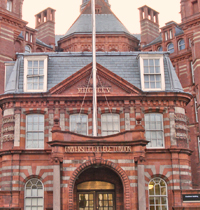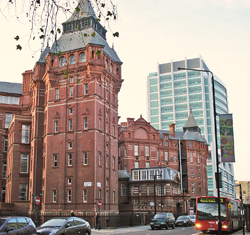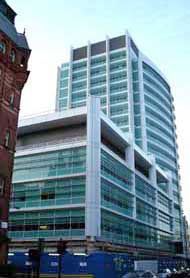University
College Hospital
Gower Street, WC1E 6AU
Medical
dates:
Medical
character:
Acute.
Teaching hospital.
The North London Hospital with
130 beds was
founded in Gower Street by University College London (UCL) in 1834.
A south wing was added to the the Hospital in
1841 and a north wing in 1846. However, by 1877 the building had
again become too small.
An appeal for the funding of a new building was launched. Sir John Blundell Maple, the head of the celebrated neighbouring furniture store in Tottenham Court Road (now closed - it has become PC World), provided the greater part of the finances. He was so impressed with the plans that he undertook to help rebuild and equip the Hospital, at an estimated cost of £100,000.
Building began in 1897 and the new Hospital on the same site in Gower street opened in 1906 with 300 beds. Now known as the 'Cruciform Building', its unusual design was an attempt to solve the problems of ventilation, drainage and lighting. The wards were arranged like the diagonal lines of a cross. They were all identical, each containing 28 beds.
By this time University College was suffering financial problems and it was felt that separation of the College and Hospital might alleviate some of the burden. This took place in 1907, the preclinical School remaining with the College and the clinical Medical School with the Hospital.
In 1914 the National Dental School merged with the Hospital and, in 1920, the Royal Ear Hospital.
In 1937 it became known as University College Hospital (UCH).
When it joined the NHS in 1948 it was designated as a teaching hospital. The University College Hospital Group was joined by St Pancras Hospital and the Hospital for Tropical Diseases, the Obstetric Hospital and the Royal Ear Hospital. (The National Temperance Hospital joined the group in 1968.)
In 1951 a Premature Baby Unit opened, It had cost £6,000 to equip, but was immediately threatened with closure due to lack of funds. Some 52% of babies admitted came from other hospitals.
By October 1954 many of the wards had been improved, with a kitchen, two side wards and bed curtains added. Each bed had a 3-way wireless, an overbed table with a formica top and a bedside locker (which had cost £14).
Food was brought up from the main kitchen to each ward in electrically heated trolleys. Breakfast was served at 07.00, lunch at 12 noon, tea at 15.30 and supper at 18.00. Patients were allowed to smoke at any time except during ward rounds (from 10.00 to 12 noon and from 14.00 to 16.00).
The Out-Patients Department was no longer a large hall, but a series of units, each with a small waiting space. The Pharmacy had a staff of 30, including 14 pharmacists.
The medical records over 25 years old were being microfilmed so that they would be available forever.
By 1959 the Hospital had 407 beds, 113 in the Private Wing and 46 in its Devonshire Street annexe (used for TB and ophthalmic patients). The Group now included the Jordan Hospital, Thomas Barlow House and the National Dental Hospital. The nursing staff numbered 900, of which 500-550 were student nurses. The Radiotherapy Department was extended; it contained a plaque placed in memory of the late singer Kathleen Ferrier, who had been treated at the Hospital.
In 1969 a new Out-Patients Department and Accident Clinic opened in Cecil Flemming House, named after the orthopaedic surgeon in recognition to his services to the Hospital.
With the reorganisation of the NHS in 1982, UCH and the Middlesex Hospital became bound together under the same administrative unit - Bloomsbury District Health Authority. In 1994 this became University College London Hospitals NHS Trust, incorporating UCH, the Middlesex Hospital, Elizabeth Garrett Anderson Hospital, the 3 Ps (Ss. Paul's, Peter's and Philip's Hospitals) and latterly the Eastman Dental Hospital, the National Hospital for Neurology and Neurosurgery and the Royal London Homeopathic Hospital, the latter two in Queen Square.
The Cruciform Building closed in 1995. Services continued in Cecil Flemming House (now demolished) in Grafton Way and in the Middlesex Hospital, until they too closed.
University College Hospital moved into its new £422m PFI-built building on Euston Road in 2006.
An appeal for the funding of a new building was launched. Sir John Blundell Maple, the head of the celebrated neighbouring furniture store in Tottenham Court Road (now closed - it has become PC World), provided the greater part of the finances. He was so impressed with the plans that he undertook to help rebuild and equip the Hospital, at an estimated cost of £100,000.
Building began in 1897 and the new Hospital on the same site in Gower street opened in 1906 with 300 beds. Now known as the 'Cruciform Building', its unusual design was an attempt to solve the problems of ventilation, drainage and lighting. The wards were arranged like the diagonal lines of a cross. They were all identical, each containing 28 beds.
By this time University College was suffering financial problems and it was felt that separation of the College and Hospital might alleviate some of the burden. This took place in 1907, the preclinical School remaining with the College and the clinical Medical School with the Hospital.
In 1914 the National Dental School merged with the Hospital and, in 1920, the Royal Ear Hospital.
In 1937 it became known as University College Hospital (UCH).
When it joined the NHS in 1948 it was designated as a teaching hospital. The University College Hospital Group was joined by St Pancras Hospital and the Hospital for Tropical Diseases, the Obstetric Hospital and the Royal Ear Hospital. (The National Temperance Hospital joined the group in 1968.)
In 1951 a Premature Baby Unit opened, It had cost £6,000 to equip, but was immediately threatened with closure due to lack of funds. Some 52% of babies admitted came from other hospitals.
By October 1954 many of the wards had been improved, with a kitchen, two side wards and bed curtains added. Each bed had a 3-way wireless, an overbed table with a formica top and a bedside locker (which had cost £14).
Food was brought up from the main kitchen to each ward in electrically heated trolleys. Breakfast was served at 07.00, lunch at 12 noon, tea at 15.30 and supper at 18.00. Patients were allowed to smoke at any time except during ward rounds (from 10.00 to 12 noon and from 14.00 to 16.00).
The Out-Patients Department was no longer a large hall, but a series of units, each with a small waiting space. The Pharmacy had a staff of 30, including 14 pharmacists.
The medical records over 25 years old were being microfilmed so that they would be available forever.
By 1959 the Hospital had 407 beds, 113 in the Private Wing and 46 in its Devonshire Street annexe (used for TB and ophthalmic patients). The Group now included the Jordan Hospital, Thomas Barlow House and the National Dental Hospital. The nursing staff numbered 900, of which 500-550 were student nurses. The Radiotherapy Department was extended; it contained a plaque placed in memory of the late singer Kathleen Ferrier, who had been treated at the Hospital.
In 1969 a new Out-Patients Department and Accident Clinic opened in Cecil Flemming House, named after the orthopaedic surgeon in recognition to his services to the Hospital.
With the reorganisation of the NHS in 1982, UCH and the Middlesex Hospital became bound together under the same administrative unit - Bloomsbury District Health Authority. In 1994 this became University College London Hospitals NHS Trust, incorporating UCH, the Middlesex Hospital, Elizabeth Garrett Anderson Hospital, the 3 Ps (Ss. Paul's, Peter's and Philip's Hospitals) and latterly the Eastman Dental Hospital, the National Hospital for Neurology and Neurosurgery and the Royal London Homeopathic Hospital, the latter two in Queen Square.
The Cruciform Building closed in 1995. Services continued in Cecil Flemming House (now demolished) in Grafton Way and in the Middlesex Hospital, until they too closed.
University College Hospital moved into its new £422m PFI-built building on Euston Road in 2006.
Present status (November 2007)
The Cruciform Building was purchased by University College London. It is now the Wolfson Institute for Biomedical Research and the preclinical teaching facility for the Medical School.

The Cruciform Building as seen from across Gower Street. The two lodges in the foreground belong to the UCL campus.

Above the main entrance 'University College London' is written in gold lettering. Previously it used to be 'University College Hospital'.

The green glass and concrete tower of the new UCH can be seen behind the Cruciform Building.

The back of the Cruciform Building in Huntley Street. Again, the new UCH can be seen in the distance.

The PFI-built Hospital as seen from Gower Street. The small tower, which replaced Cecil Flemming House in Grafton Way, is soon to be finished (2008) and will be the Elizabeth Garrett Anderson Wing. The corner of the Cruciform Building can just be seen on the left.

The Middlesex Tower, named after the Middlesex Hospital, as seen from Euston Road.
The Scottish surgeon Robert Liston
(1794-1847), famed for his surgical skills and rapid amputations,
performed the
first amputation under ether anaesthesia in England here at UCH in 1846.
Barry G, Carruthers LA 2005 A History of Britain's Hospitals. Sussex, Book Guild Publishing.
Black N 2006 Walking London's Medical History. London, Royal Society of Medicine Press.
Merrington WR 1976 University College Hospital and its Medical School: a History. London, Heinemann
http://archiseek.com
http://en.wikipedia.org
http://hansard.millbanksystems.com
www.aim25.ac.uk
www.british-history.ac.uk
www.geograph.org.uk
www.theguardian.com
www.ucl.ac.uk
www.uclh.nhs.uk
www.uclh.org
www.waterloo.co.uk
Return to home page